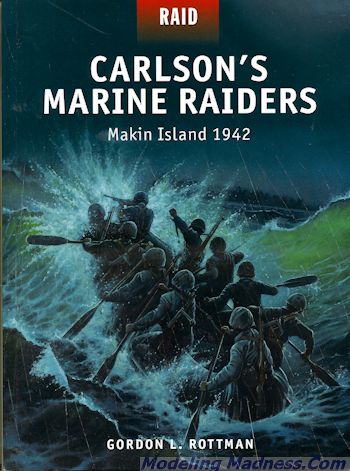 n the first
year of WWII in the Pacific, things were generally pretty bleak in terms of US
offensive operations. Several were staged simply to boost morale or to convince
the Japanese that they were not as 'safe' as they thought they were. One was the
Doolittle Raid which succeeded in keeping units at home for defense that could
have better been used elsewhere. Another was the Makin Raid of August 1942.
n the first
year of WWII in the Pacific, things were generally pretty bleak in terms of US
offensive operations. Several were staged simply to boost morale or to convince
the Japanese that they were not as 'safe' as they thought they were. One was the
Doolittle Raid which succeeded in keeping units at home for defense that could
have better been used elsewhere. Another was the Makin Raid of August 1942.
This particular event had some rather interesting
background to it. Once the war in Europe got under way, the US has observers
with the British and one thing they saw were commandos. It was felt that raider
units like this would be useful in the US for their operations in the Pacific
and would be perfect for the USMC. Plans for this sort of unit were championed
by LtCol Evan Carlson and Captain James Roosevelt (son of the President).
Carlson was a rather odd bird to say the least and once
the OK was given to develop raider units in early 1942, he started gathering
together troops. He was an adherent to what he called the 'Gung Ho' philosophy
where every man in the unit worked together. He set up an almost socialist unit
where officers and men all worked together with no differences in rank. When
there were difficulties, he got entire groups together to work them out. No
man's opinion was considered better than another's, a rather radical concept for
any military unit. The units trained until they dropped with Carlson only taking
those into his command that he thought would be able to fit in. Needless to say,
this brought about some issues as many in the Marine Corps did not like the idea
of elite units and felt that what Carlson and Roosevelt had in mind should be
something that any Marine should be able to do.
Eventually, the units were trained to the max and ready
for an operation. The idea was to send ashore a raiding party of some 200 men to
destroy facilities, gather intelligence and bring back prisoners. The target had
to be relatively isolated and somewhat near to US lines. Plans for raids on
Kiska, the Japanese mainland and Tinian were shelved due to the distances and so
it was that Butaritari (Makin) was chosen. This was a forward Japanese seaplane
base that had a radio station or two on it as well as the requisite Japanese
soldiers. Coming at the same time as the Guadalcanal operation, it was hoped
that the Japanese would send troops from Guadalcanal to Makin to reinforce it.
This did not happen.
The plan was to use two cruiser submarines, the USS
Argonaut and USS Nautilus to carry the troops close to the landing beaches and
then have the raiders go ashore in rubber boats, do their thing, and return. It
was planned for this to last no more than a day.
Well, as is often the case in wars, things did not go
well. The surf was heavier, the number of Japanese on the island was unknown and
the actual operation did not go at all according to plans. In other
circumstances it would have been a disaster, but the American public was hungry
for any good news and the raid did succeed in destroying facilites and most of
the men got back. What's more, it showed up deficiencies that were corrected for
the raider's next campaign at Guadalcanal.
The author covers the usual preamble of this series
covering the beginnings of the raider battalions as well as the life of Evan
Carlson. It goes into great detail on the training of the unit and also in the
operation at Makin itself. It also covers what happened to the troops that were
left on the island and the lack of proper accountability by the raiders
themselves who did not get a proper head count until back at Pearl Harbor. The
book is superbly illustrated with period photos as well as artwork and charts to
help us understand the flow of the operation. A fine read that
I know you will enjoy reading and should raise an eyebrow now and then.
August 2014
For more on the complete line of Osprey books,
visit www.ospreypublishing.com. In the US, it is
Osprey Direct at 44-02 23rd St, Suite 219, Long Island City, NY 11101., where you can
get a catalogue of available books.
If you would like your product reviewed fairly and quickly, please
contact
me or see other details in the Note to
Contributors.
 n the first
year of WWII in the Pacific, things were generally pretty bleak in terms of US
offensive operations. Several were staged simply to boost morale or to convince
the Japanese that they were not as 'safe' as they thought they were. One was the
Doolittle Raid which succeeded in keeping units at home for defense that could
have better been used elsewhere. Another was the Makin Raid of August 1942.
n the first
year of WWII in the Pacific, things were generally pretty bleak in terms of US
offensive operations. Several were staged simply to boost morale or to convince
the Japanese that they were not as 'safe' as they thought they were. One was the
Doolittle Raid which succeeded in keeping units at home for defense that could
have better been used elsewhere. Another was the Makin Raid of August 1942.